The 16th May 2018 marked a momentous occasion for the National Gallery of Zimbabwe (NGZ) when an event to greet three Old Italian Master paintings, that had been on loan from the Permanent Collection, were returned back from the UK namely: “Patriarch” and Astronomer” by Paolo Veronese and “The King of Poland being welcomed by the Doge of Venice” by Andrea Piazza. The works are dated from the Late Renaissance to the Baroque. The three artworks are of the zenithal degree and have been an integral part of the NGZ’s Permanent Collection’s lineament of Global Art History.
For the past 21 years the paintings were housed at Eltham Palace, a royal residence from the 14th to the 16th century and the childhood home of King Henry VIII of Tudor. The Palace is located in Greenwich near London and administered by a charity called English Heritage who manage and conserve over 400 historic buildings and sites in the UK. The Tudorian mansion was re-designed to the Modernist tastes of Sir Stephen and Lady Virginia Courtauld when they took up residence in the 1930’s, then twenty years later, in the 1950’s they retired in Zimbabwe.
During the restoration of the Eltham Palace, the Director of Museums and Collections of the English Heritage requested to borrow the three master paintings for display. After years of correspondence, the works finally arrived in London on the 6th of July 1999 from Zimbabwe. They were hung in the Italian Drawing Room where they were originally when Sir Stephen and his wife lived there. The paintings thematically cohering to the eloquence of the space, evoking Renaissance zeal to the mise en scène in which they were housed.
The loan of the artworks made them accessible to new audiences who were able to be inspired, learn and enjoy. Galleries are committed to making their collection widely available to museums and galleries around the world and supporting important exhibitions. Collections are a valuable public resource, reflecting the generosity of past and current donors and public investment in their continued care and development. Borrowing and lending are the lifeblood of gallery outreach programmes, offering new perspectives on our world and its cultures, and the sharing of collections, contributes to their interpretation and increases the benefit they can provide for the public.
The return of these artworks back into the NGZ’s Permanent Collection has a basis of association between a triumvirate of institutions with a common Patron. The benefactor being Sir Stephen Courtauld who was born in the UK in 1883 was a soldier, philanthropist and heir of the English wealthy Courtauld family of textile industrialists. Sir Stephen directed his interests to the advancement of the Arts, not only in the United Kingdom, but all over the world. When Sir Stephen and Lady Virgina retired to Zimbabwe they built a French style tower and house, with Welsh slate roof tiles in the beautiful Imbeza Valley, Penhalonga.
 La Rochelle Country Estate which is now a leading boutique hotel
La Rochelle Country Estate which is now a leading boutique hotel
Throughout the span of his life, as his family before him, he led a life that was inarguably non-conformist and an example of his pursuit for social justice can be seen at La Rochelle. A window at the house has inscribed within it, the names and signatures of scores of revolutionaries who sought abode there, en route to Mozambique during the Second Chimurenga. Arguably, being a military man himself, bequeathing wealth and artwork to what was then the National Gallery of Rhodesia; one marvel’s at the man’s nobility in his dichotomous support of needs of all within that body politic that was all embracing to cultural diversity.
Sir Stephen was a keystone in the establishment of the NGZ. Throughout the inception process, the opening and the development of the institution, Sir Stephen applied great fervour to the functionality of the organization to such a degree he was appointed the Chairman Emeritus until the time of his passing. The couple, who died in 1967 and 1972 respectively, became the first patrons of the gallery and donated La Rochelle to the National Trust of Zimbabwe. In his Will all beneficiary institutions were to freely distribute artworks between themselves for the enjoyment and enrichment of the cultural lives of the Public wherever he donated artworks. His legacy and foresight led to the loan of the paintings to Eltham Palace.
At the ‘welcome home’ reception for the paintings an excited audience gathered, appropriately, in the Courtauld Gallery at the NGZ for the celebrations. The backdrop for the official event was the exquisite painting entitled: “The King of Poland being received by the Doge of Venice” by Andrea Piazza.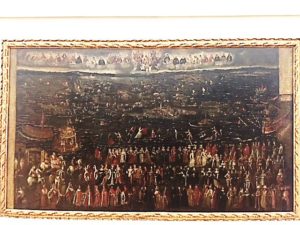
“The King of Poland being received by the Doge of Venice” by Andrea Piazza.
The painting captures the King’s festive entry that took place on July 18 1574. The waterscape of the middle ground is festooned with gondolas navigating the Grand Canal as they shift towards the eye to dock before reception by the court and High Society of Venice. The linear perspective of the composition shifts the eye towards the vanishing point, where atop, the Saints watch the events unwrapping below with approval, the veneer in this section establishing the painter’s exquisite application of chiaroscuro wherein the darker tones of the foreground express the aggregation’s earthiness and mortality.
The proceedings began with Mr Raphael Chikukwa, Deputy Director, Chief Curator on behalf of the NGZ welcomed the return of the three Italian masters paintings and acknowledged the presence of the Director of the British Council Mrs S Harvey and all other distinguished guests. He said that this was a unique event in so many ways that started when the Executive Director and himself visited the UK and had the opportunity to meet with the Courthauld Institute then follow through with various discussions until it was agreed that these important artworks be returned to Zimbabwe.
The artworks were originally left to the NGZ by Sir Stephen who also donated a lot of funds to establish and support many institutions in Zimbabwe that included the construction of the NGZ, which we are all enjoying today as Zimbabwean’s. Sir Stephen also donated his entire old masters collection to the NGZ. So I would say he was our biggest philanthropist in this country and for us as the NGZ we were one of the biggest beneficiaries of his donations. Mr Chikukwa asked for an acknowledgement for the late Sir Stephen and for the legacy that he left behind.
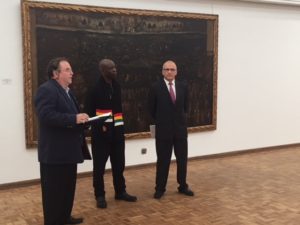 From left to right: Mr D Scott, Mr R Chikukwa and Mr Roberto Franceschinis
From left to right: Mr D Scott, Mr R Chikukwa and Mr Roberto Franceschinis
He added that there are a number of philanthropists in the world but Sir Stephen was a rare one whose work can be seen through these paintings. He thanked the NGZ committee for being able to put up such up historic exhibition which also called upon local Zimbabwean artists who took up the call to collaborate and participate by creating works especially to welcome the three paintings home.
He explained how Mrs Lillian Chaonwa, the Conservation Manager went to the UK to personally oversee the packaging and transportation of the paintings from the UK to the Netherlands, then from the Netherlands to Zimbabwe. He said that there is no other person better placed than Mrs Chaonwa to do so and for which she is highly valued at the gallery where she has worked for more than twenty years. Mrs Chaonwa has also fostered relationships with many galleries around the world such as the Tate Modern and galleries in Uganda. He asked everyone present to give her a big pom pom.
Mr Chikukwa handed over to Mr David Scott, Chairman of the NTZ who took the chance to illustrate the existence and importance of protecting our national heritage. He explained the background, purpose, aims and objectives of the NTZ who protect the seven properties for the future benefit of the people of Zimbabwe and for overseas visitors, with La Rochelle being the flagship property.
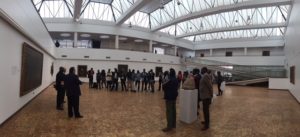 Mr Scott (2nd on the right) addressing the audience
Mr Scott (2nd on the right) addressing the audience
Mr Scott explained that the NTZ conducts tangible and intangible activities and conducts heritage education and other cultural projects. The La Rochelle site has direct links to the artworks being re-housed and exhibited today through the Courtauld family who bequeathed that property to NTZ and who also donated these and many other paintings to the NGZ. He pointed out that Sir Stephen was knighted in 1958 for his services to Zimbabwe and for his cultural and philanthropic work in Zimbabwe. Sir Stephen gave away an estimated £1m in gifts and money towards helping art, music, education and race relations in Zimbabwe.
Donations included:
Mutare – Queens Hall and Courtauld Theatre, The Bulawayo Theatre; College of Music, Ranche House College, St Michaels Church Harare, Nyatsime College Library, University of Zimbabwe, the establishment of Kukwanisa Agricultural Training Centre; Rhodes Club Mutare (the first multiracial club in the country, enabling the building of the NGZ through generous financial support and numerous artwork donations, National Museum and bequests to the NTZ and the Zimbabwe Academy of Music.
He said that it is rumoured that discussions about the original ZANU constitution were held at La Rochelle and this theory is supported by the existence of signatures of political figures such as Ndabanigi Sithole and Herbert Chitepo and other nationalists on two special windows at La Rochelle containing hundreds of signatures of people who visited La Rochelle at the time the Courtaulds resided there. Mr Scott then gave a short history of Eltham Palace which is one of the few important medieval royal palaces in England to survive with substantial remains intact. Initially a moated manor house with vast parkland, it was acquired by the future Edward II in 1305. Mr Scott thanked the NGZ for the opportunity to participate in this important exhibition and added he was happy to have been able to provide the historical background of the Exhibition.
The final address was made by Mr Roberto Franceschinis, the Acting Ambassador of Italy, who greeted everyone and started by thanking the NGZ for inviting him to be the Guest of Honour on such an extraordinary occasion, by virtue of the fact that the paintings of which today we celebrate the homecoming, were created by Italian Masters some 400 years ago. They integrate a remarkable collection of old Italian Masters which places the NGZ at the forefront of cultural destinations in the Region, and which we have the privilege to admire here today.
Mr Franceschinis then gave a brief introduction about the three artists:
Paolo Caliari, in art “Il Veronese” (1528-1588) was a late Renaissance painter who soon developed his own taste for a more vivid palette of colors. According to Gauthier, a French critic of the nineteenth century, Veronese is the greatest colorist that ever lived, greater than Tiziano, Rubens or Rembrandt in his ability to harmonize natural tones to render light without violent contrasts, as opposed to the academic chiaroscuro technique of the time.
After the successful completion of the frescos at Villa Barbaro, a new palace in the outskirts of Venice designed by the renowned architect Palladio, a mature Veronese is commissioned with decorating the Hall of the Grand Council in the Palazzo Ducale. An immense oval named “The triumph of Venice” establishes Veronese as the true beacon of the intellectual progressiveness and civic liberalism that made Venetian society the most culturally advanced at the time, as opposed to the regressive, neo-feudal, moralistic involution that was taking hold across Europe and which would soon disembark at Venice itself to influence his latest years.
Andrea Piazza (1587-1670) was born in Castelfranco, a small town near Venice, was initiated to the art of painting in the city of Venice under the guidance of his uncle Paolo, at the time an accomplished artist himself, who had taken religious orders becoming a Capuchin friar. This was now well into the period of Catholic resurgence, a return to a more conservative religious discipline in response to the Protestant Reformation, a troubled time indeed in Europe ending only at the close of the “Thirty Years War” in 1648. Upon request from his superiors, Friar Cosmo and his nephew Andrea reached the court of the Roman Catholic Emperor Rudolph the II of Augsburg in Germany, where they spent years to glorify with frescos and paintings the eternal beatitude that the Faithful attain in paradise, as opposed to the misery and unyielding suffering of the heretics, among which they included Luther and many others. It is said that the representations were so lively and convincing, not only to achieve the desired effect quite successfully but also to echo all the way to Rome, where the two were finally drawn on the request of the Pope himself. A now mature Andrea became soon known as an excellent painter, and in later years moved first to the court of the Duke of Lorraine in France, where he was knighted in appreciation of his masterly skills, and finally back to the Republic of Venice, where he remained at the service of the Doges, and where, among many others, he realized this extraordinary piece of art.
During his closing he commended Mrs. Doreen Sibanda, Executive Director of the NGZ, together with the Curator Mr. Raphael Chikukwa and staff for their unrelenting commitment to bring such extraordinary pieces of art back where they belong, to mark not the closing of a chapter, but the onset of a new one, dedicated to treasuring these masterpieces as part of this Country’s own history to the benefit and enjoyment of present and future generations of Zimbabweans.
He then quoted Brian Bradshaw, a former Executive Director:
“It’s not to be expected that the work of the Gallery will ever be simple, perhaps also it is not to be hoped that it should be so, because art, which blends the Past with the Future into a continually expanding Present, is not of a nature to equip itself with anything less than the least simple of efforts.”
Mrs Lilian Chaonwa gave a vote of thanks the English Heritage Team at Eltham Palace who took such good care of the three paintings and returned them to the National Gallery in a pristine condition. She also thanked Mrs Samantha Harvey Director of the British Council Zimbabwe who funded the Executive Director and Deputy Director’s trip to the UK which was the beginning of the talks to return the paintings. She also gave special thanks to the NTZ and the Italian Embassy.
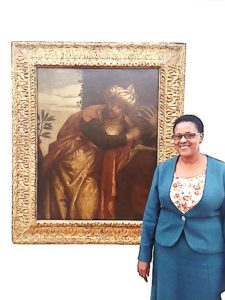 “Astronomer” by Paolo Veronese and Mrs Lilian Chaonwa, Conservation Manager
“Astronomer” by Paolo Veronese and Mrs Lilian Chaonwa, Conservation Manager
The Astronomer, wherein a draped man reclines with astrolabe in hand, the countenance on his face bears intrinsic thought and contemplation as a man of that station was classically entailed. The dark and light tones of the composition are rich and the warm colour is radiant, with the texture of the natural distinctly standing apart from the drapery, sharply creased and filling the eye pleasingly with its voluminous appearance.
Of special note are the local artists that responded to the Zimbabwe Meets Italy exhibition in a very short period of time and with such breath-taking results. Down in the Courtauld Gallery were two mixed media pieces from Greg Shaw, along with appropriate artworks from the Permanent Collection including an oil on canvas of “David And The Head Of Goliath” by Giovanni Battista Caracciolo, works by Rashid Jogee and a metal sculpture of David slaying Goliath acquired by the Friends of the Gallery. Upstairs in the South Gallery and along the passage to the PC Gallery were some very creative works by the following artists: Lilian Magodi, Tawana Reza, Clive Mukucha, Progress Nyandoro, Munyaradzi Mazaririe, Munyaradzi Mangate, Anthony Bumhira and Percy Manyonga.
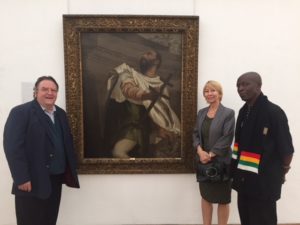 “The Patriot” by Veronese Paolo: Oil on canvas 135 x 104 cm with (left to right) Mr D Scott: Chair NTZ, Mrs S Waterworth: Vice Chair NTZ and Mr Chikukwa: Chief Curator
“The Patriot” by Veronese Paolo: Oil on canvas 135 x 104 cm with (left to right) Mr D Scott: Chair NTZ, Mrs S Waterworth: Vice Chair NTZ and Mr Chikukwa: Chief Curator
After the speeches the audience who included members of Government, representatives of the Diplomatic Corps, The Directorate of the National Museum and Monuments of Zimbabwe, representatives of the National Archives of Zimbabwe, the National Arts Council of Zimbabwe, The National Trust of Zimbabwe and The British Council of Zimbabwe, artists, cultural practitioners, art lovers and art students began to disburse and enjoy seeing the rare art works on display after being served refreshments.
The NTZ would like to thank the NGZ for providing their technical input into this article.





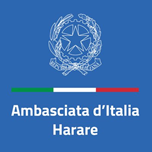

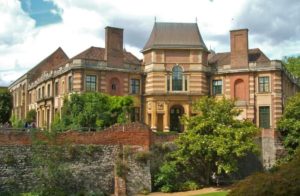


 USE NUMBER: 0775 907 595
USE NUMBER: 0775 907 595